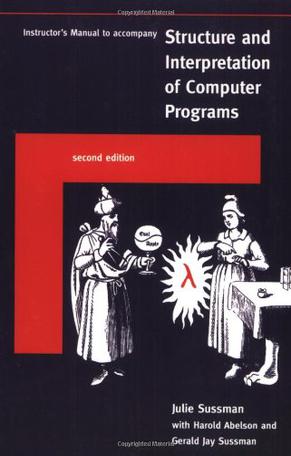-

Instructor's Manual t/a Structure and Interpretation of Computer Programs
This instructor's manual and reader's guide accompanies the second edition of Structure and Interpretation of Computer Programs, by Harold Abelson and Gerald Jay Sussman with Julie Sussman. It contains discussions of exercises and other material in the text as well as supplementary material, additional examples and exercises, and teaching suggestions. An appendix summarizes the Scheme programming language as used in the text, showing at what point in the text each element of Scheme is introduced. -

The Seasoned Schemer
drawings by Duane Bibbyforeword and afterword by Guy L. Steele Jr.The notion that "thinking about computing is one of the most exciting things the human mind can do" sets both The Little Schemer (formerly known as The Little LISPer) and its new companion volume, The Seasoned Schemer, apart from other books on LISP. The authors' enthusiasm for their subject is compelling as they present abstract concepts in a humorous and easy-to-grasp fashion. Together, these books will open new doors of thought to anyone who wants to find out what computing is really about. The Little Schemer introduces computing as an extension of arithmetic and algebra;things that everyone studies in grade school and high school. It introduces programs as recursive functions and briefly discusses the limits of what computers can do. The authors use the programming language Scheme, and interesting foods to illustrate these abstract ideas. The Seasoned Schemer informs the reader about additional dimensions of computing: functions as values, change of state, and exceptional cases. The Little LISPer has been a popular introduction to LISP for many years. It had appeared in French and Japanese. The Little Schemer and The SeasonedSchemer are worthy successors and will prove equally popular as textbooks for Scheme courses as well as companion texts for any complete introductory course in Computer Science. -

The Art of the Metaobject Protocol
The CLOS metaobject protocol is an elegant, high-performance extension to the CommonLisp Object System. The authors, who developed the metaobject protocol and who were among the group that developed CLOS, introduce this new approach to programming language design, describe its evolution and design principles, and present a formal specification of a metaobject protocol for CLOS.Kiczales, des Rivieres, and Bobrow show that the "art of metaobject protocol design" lies in creating a synthetic combination of object-oriented and reflective techniques that can be applied under existing software engineering considerations to yield a new approach to programming language design that meets a broad set of design criteria.One of the major benefits of including the metaobject protocol in programming languages is that it allows users to adjust the language to better suit their needs. Metaobject protocols also disprove the adage that adding more flexibility to a programming language reduces its performance. In presenting the principles of metaobject protocols, the authors work with actual code for a simplified implementation of CLOS and its metaobject protocol, providing an opportunity for the reader to gain hands-on experience with the design process. They also include a number of exercises that address important concerns and open issues.Gregor Kiczales and Jim des Rivieres, are Members of the Research Staff, and Daniel Bobrow is a Research Fellow, in the System Sciences Laboratory at Xerox Palo Alto Research Center. -

ANSI Common Lisp
For use as a core text supplement in any course covering common LISP such as Artificial Intelligence or Concepts of Programming Languages. Teaching students new and more powerful ways of thinking about programs, this text contains a tutorial-full of examples-that explains all the essential concepts of Lisp programming, plus an up- to-date summary of ANSI Common Lisp, listing every operator in the language. Informative and fun, it gives students everything they need to start writing programs in Lisp both efficiently and effectively, and highlights such innovative Lisp features as automatic memory management, manifest typing, closures, and more. -

ANSI Common Lisp
For use as a core text supplement in any course covering common LISP such as Artificial Intelligence or Concepts of Programming Languages. Teaching students new and more powerful ways of thinking about programs, this text contains a tutorial-full of examples-that explains all the essential concepts of Lisp programming, plus an up- to-date summary of ANSI Common Lisp, listing every operator in the language. Informative and fun, it gives students everything they need to start writing programs in Lisp both efficiently and effectively, and highlights such innovative Lisp features as automatic memory management, manifest typing, closures, and more. -

Clojure in Action
DESCRIPTION Clojure is a new version of Lisp that runs on the Java Virtual Machine. It's a functional language, which means that it's ideal for the growing need for concurrent programming and for specialized tasks like creating domain specific languages. Clojure in Action is a hands-on tutorial for the working programmer who has written code in a language like Java or Ruby, but has no prior experience with Lisp. It teaches Clojure from the basics to advanced topics using practical, real-world application examples. Readers will move quickly through the theory and dive into practical matters like unit-testing, environment set up, and all the way through building a scalable web-application using domain-specific languages, Hadoop, HBase, and RabbitMQ. KEY POINTS * A complete tutorial, from basics to applied techniques * Covers creation of Domain-Specific Languages * Contains numerous practical examples